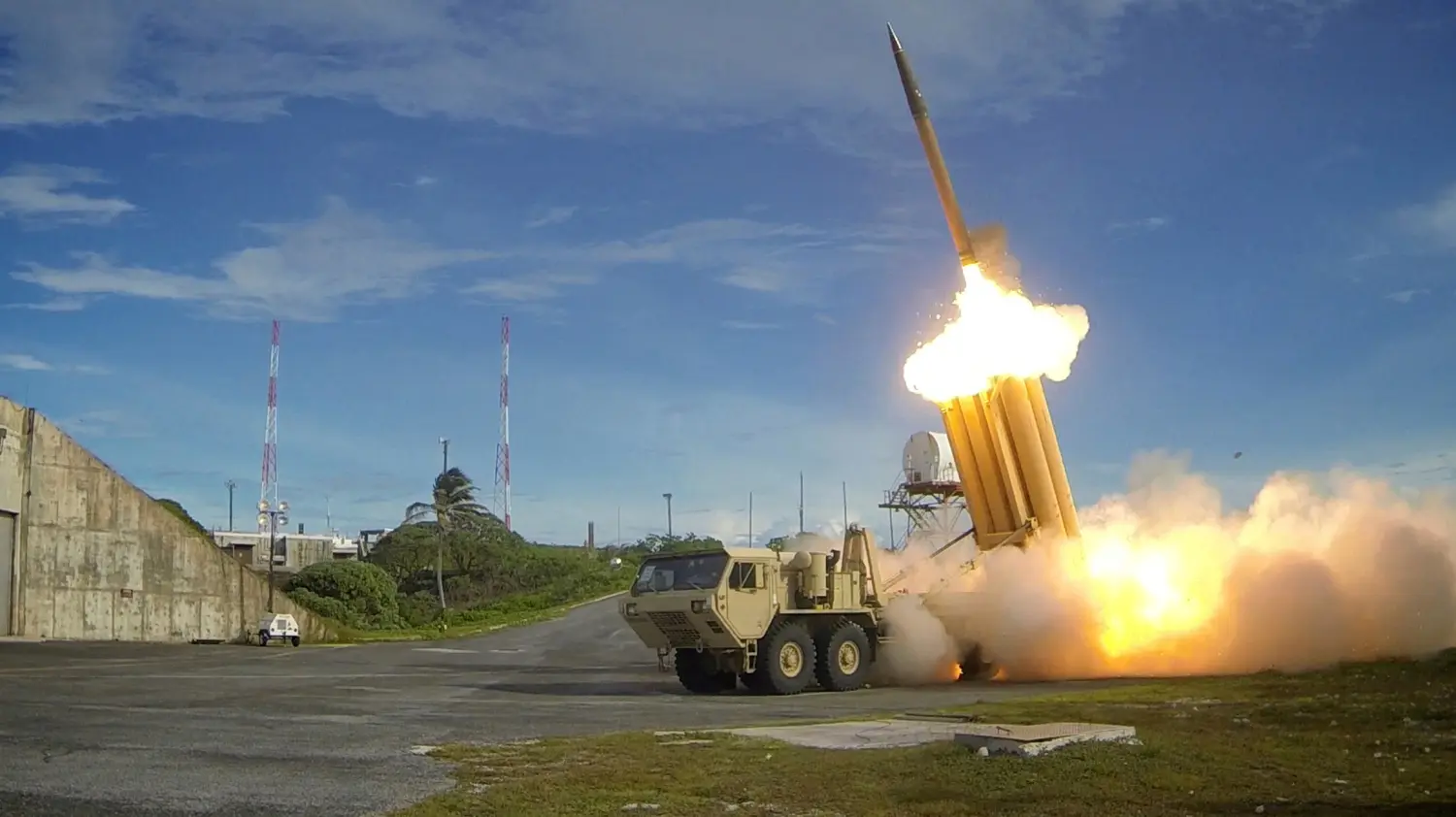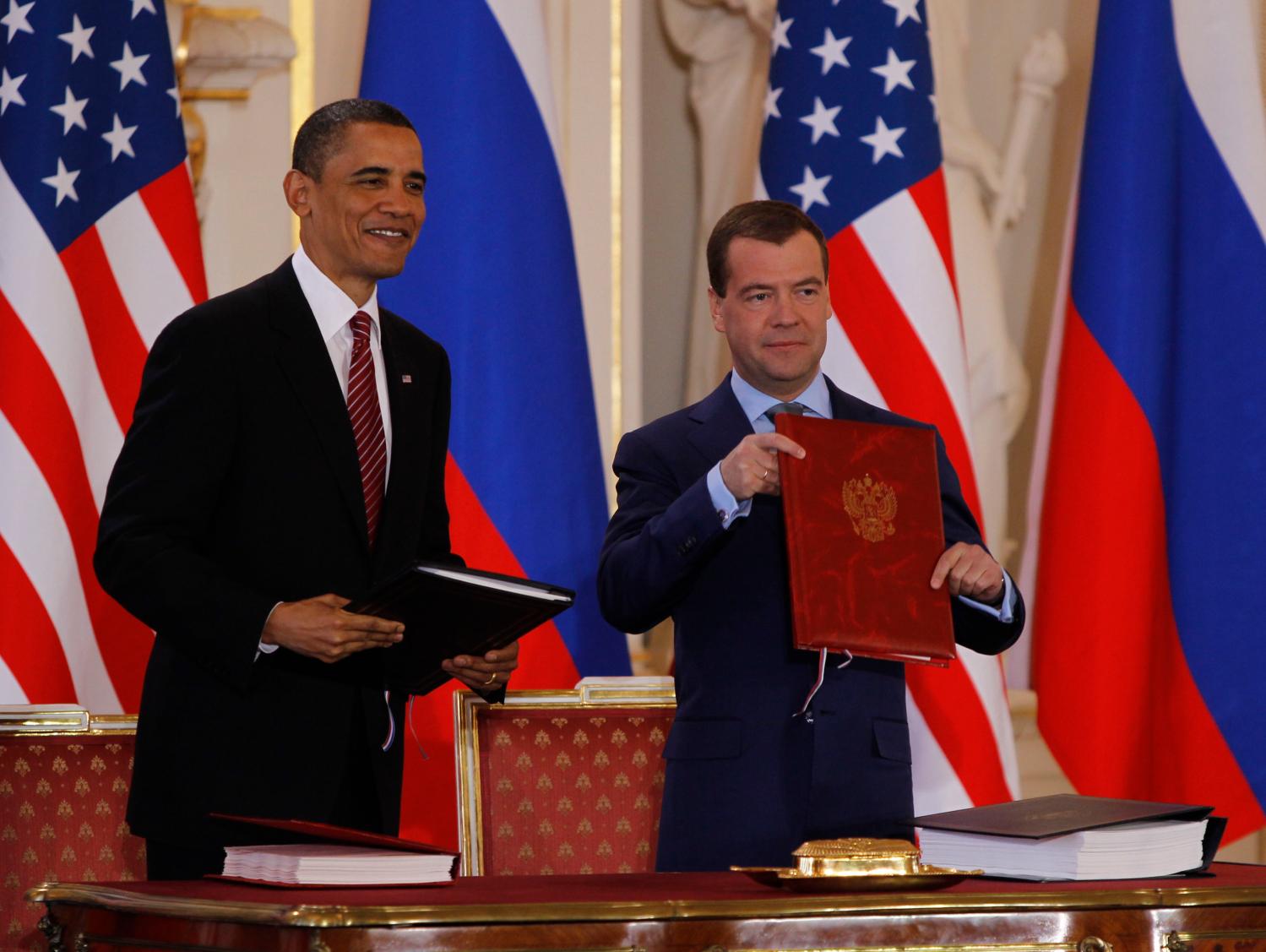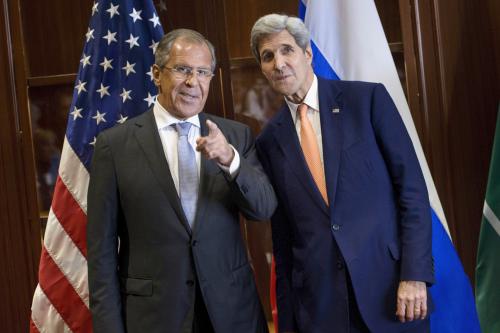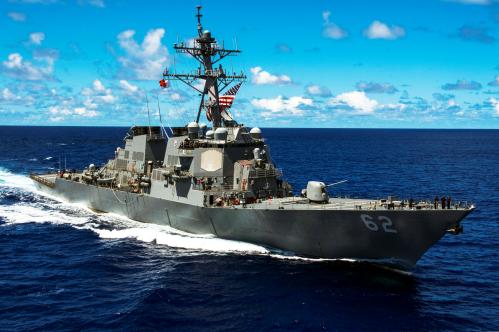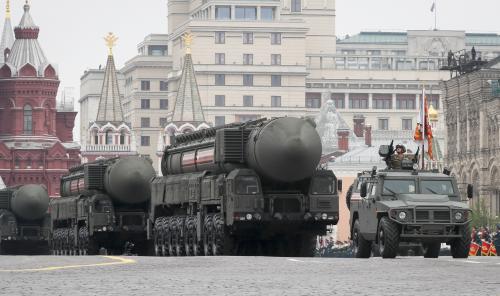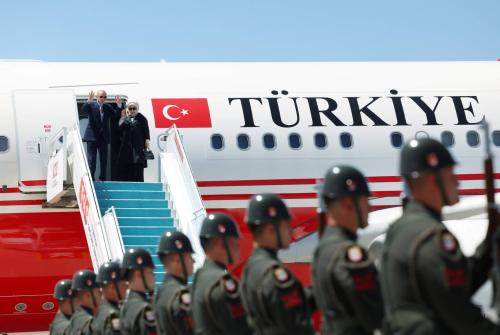The following brief is part of Brookings Big Ideas for America—an institution-wide initiative in which Brookings scholars have identified the biggest issues facing the country and provide ideas for how to address them. (Updated January 26, 2017)
 Arms control can make a significant contribution to U.S. security and is more important when relations are adversarial than when they are working. The Trump administration should prepare a position in case Moscow decides to reengage. It should seek a negotiation on further nuclear arms reductions that would include all U.S. and Russian nuclear weapons while also indicating that it is prepared to address the related issues raised by the Russians. Doing so could revive the arms control dialogue and perhaps produce agreements that would strengthen U.S. and allied security.
Arms control can make a significant contribution to U.S. security and is more important when relations are adversarial than when they are working. The Trump administration should prepare a position in case Moscow decides to reengage. It should seek a negotiation on further nuclear arms reductions that would include all U.S. and Russian nuclear weapons while also indicating that it is prepared to address the related issues raised by the Russians. Doing so could revive the arms control dialogue and perhaps produce agreements that would strengthen U.S. and allied security.
ARMS CONTROL AND RUSSIA
Russia is the one country that could physically destroy America. Successive administrations since the 1960s have sought to limit and reduce the number of Soviet and Russian nuclear weapons that could threaten the United States. Enhancing strategic stability—minimizing the incentives a side might have to use nuclear weapons first in a crisis—has served as a prime motivator for U.S negotiating efforts. Other reasons include increasing transparency and predictability, reducing the costs of U.S. nuclear forces, and bolstering America’s nonproliferation credentials.
Negotiations between Washington and Moscow have produced a string of agreements. These agreements and the two countries’ unilateral measures have dramatically reduced the number of their nuclear weapons. When the 2010 New Strategic Arms Reduction Treaty (New START) is fully implemented in February 2018, the United States and Russia will each be limited to no more than 1,550 deployed strategic warheads on no more than 700 deployed strategic ballistic missiles and bombers. The total U.S. nuclear stockpile—including nondeployed (reserve) strategic warheads and nonstrategic nuclear weapons—numbers some 4,500 weapons. Russia is believed to have a stockpile of roughly equivalent size.
[T]he overall political relationship between Washington and Moscow has tumbled to a nadir.
Over the past few years, a clear difference has emerged between the U.S. and Russian approaches, contributing to the current standstill in the arms control dialogue. The Obama administration sought further cuts in U.S. and Russian nuclear weapons, but Moscow focused on questions such as missile defense, advanced conventional strike systems, and third-country nuclear forces. Meanwhile, the overall political relationship between Washington and Moscow has tumbled to a nadir. Ukraine and Syria remain points of contention. Problems have arisen with existing arms control arrangements. The U.S. government in 2014 announced that Russia had violated the 1987 Intermediate-range Nuclear Forces (INF) Treaty by testing a ground-launched cruise missile of intermediate range. (U.S. allies in Europe and Asia want to see the treaty preserved.)
The more belligerent approach that Russia has adopted toward the United States and West comes against the backdrop of a major Russian military modernization effort, including modernization of its strategic nuclear forces, though much of that aims to replace older systems that are aging out. Putin and other Russian officials have engaged in nuclear saber-rattling of a kind not seen since the Cold War. The Kremlin seems to prefer an adversarial relationship, driven in part by domestic political factors and a sense of grievance against the United States and West.
Although U.S. and Russian interests clash on a number of issues, they converge on other questions, where Washington and Moscow have cooperated. These include the efforts to curb Iran’s nuclear arms program and eliminate Syria’s chemical weapons. The bilateral relationship for the foreseeable future will likely consist of confrontation on some questions mixed with issues where the two cooperate, though the balance has shifted in the direction of greater confrontation. It is not clear how quickly this might be changed.
If anything, the downturn in U.S.-Russia relations makes agreements such as New START count more. Having a cap on the other’s strategic nuclear capabilities and transparency measures that provides enhanced predictability regarding the other’s nuclear forces is more valuable in times of tension than when the bilateral relationship is working well.
If anything, the downturn in U.S.-Russia relations makes agreements such as New START count more. Having a cap on the other’s strategic nuclear capabilities and transparency measures that provide enhanced predictability regarding the other’s nuclear forces are more valuable in times of tension than when the bilateral relationship is working well.
There are currently few grounds for optimism about near-term arms control prospects, but one should not completely write them off. Russian officials reportedly said they might be prepared to reengage on nuclear arms control once New START is fully implemented in February 2018. The tone and substance of the arms control dialogue between Washington and Moscow have changed dramatically in the past—often in connection with a change of leadership in one of the capitals.
While President Trump should not expect such a positive reversal, he should not exclude it. If the Russians indicate a readiness to reengage, Washington will need a position on reducing nuclear forces and related questions. Without appearing too eager, the Trump administration should look for an opportunity to signal to Moscow that it is open to a resumed dialogue on nuclear arms control and is prepared to discuss related questions raised by the Russians. A security deal may be doable.
Even if the Kremlin is not prepared to reengage, there may still be value in a forward-looking position on arms control. It can be important for sustaining allied support, including for the modernization of U.S. nuclear forces. Moreover, the UN General Assembly has mandated a negotiation aimed at concluding a ban on nuclear weapons—which most, if not all, nuclear-armed states will boycott. That negotiation will invariably result in more international pressure on the United States than others. Having an arms control position calling for further U.S. and Russian nuclear reductions would put Washington in a better position to withstand such pressure.
NUCLEAR WEAPONS, RELATED ISSUES, AND OPTIONS
Strategic modernization. The Trump administration will inherit the modernization program of record that the Obama administration deemed necessary to meet its strategic force requirements, entailing a new ballistic missile submarine, a new intercontinental ballistic missile (ICBM), a new bomber, and a new nuclear-armed air-launched cruise missile. The new administration will want to review this program, including whether it is affordable. Many believe that it is not, or that it can be funded only by taking resources from critical conventional military capabilities.
New START allows the United States and Russia each to maintain up to 1,550 deployed strategic warheads on no more than 700 deployed strategic ballistic missiles and bombers. The Pentagon has planned a force of 700 deployed ICBMs, submarine-launched ballistic missiles (SLBMs), and nuclear-capable bombers. The Trump administration’s review could ask: Does the United States need to maintain a triad of ICBMs, SLBMs, and bombers? Should the numbers planned by the Obama administration be adjusted? Should the Pentagon proceed with the new nuclear-armed air-launched cruise missile?
Further nuclear reductions. As for dealing with Russia, the administration will have to decide whether and when it might seek to extend the New START Treaty, which expires by its terms in 2021 but can be extended for up to five years. Should Moscow be prepared for negotiations going beyond New START, the administration will have to decide whether to seek to reduce limits on deployed strategic warheads and deployed strategic delivery vehicles and, if so, by how much. It will need to weigh other questions related to New START, such as whether it would want to change the counting rules for bomber weapons, which attribute each deployed bomber with only one deployed strategic warhead, even though they can carry many more.
The Trump administration should consider how to deal with reserve strategic nuclear warheads and nonstrategic nuclear weapons, which the Obama administration sought to bring into a negotiation of a follow-on treaty to New START. These weapons are unconstrained. Their relative importance in the nuclear balance grows as the number of deployed strategic warheads is reduced. Would a negotiation be possible for an aggregate limit that would cover all U.S. and Russian nuclear weapons as opposed to just deployed strategic arms?
Missile defense. Missile defense has been a difficult issue on the U.S.-Russian agenda. Moscow seeks to limit U.S. capabilities in this area. Are there options regarding missile defenses, particularly missile defenses in Europe, which Washington could exercise that might interest Moscow and could Washington secure Russian agreement to further nuclear arms reductions?
Advanced conventional strike weapons. The Russians have raised advanced conventional strike systems as potentially affecting the strategic nuclear balance, given the increasing accuracy of conventional weapons. The main issue appears to be long-range hypersonic glide vehicles, which both sides are developing though neither has yet deployed. These would not be limited by New START. The Obama administration regarded these as a “niche” capability and planned to build only a small number. Would it be possible to constrain such weapons in a way that would remove them as a problem issue on the agenda? A separate question is whether and how to deal with conventionally armed cruise missiles.
Third-country nuclear forces. Arms control cannot forever remain a U.S.-Russian enterprise, but expanding the process to bring in third countries is complicated, in part owing to the disparity in numbers between the United States and Russia on the one hand (about 4,500 nuclear weapons each), and all other nuclear weapons states on the other (no more than 300 weapons each). One might first look at bringing in the United Kingdom, France, and China, perhaps by having them adopt unilateral commitments and/or transparency measures.
RECOMMENDATIONS
Nuclear posture review. The Trump administration should carry out a nuclear posture review early in its term to examine the requirements for U.S. nuclear forces and policy and whether current and planned nuclear forces meet those requirements. Special attention should go to Russia, given the size and variety of its nuclear forces, the more belligerent stance it has adopted toward the West, and Moscow’s loose talk about nuclear use.
The nuclear posture review should examine the U.S. force structure and planned modernization program and ask if that is the right structure and whether it is affordable. Ideally, requirements, policy, and strategy, rather than budgets, dictate force structure. It would be unwise, however, not to factor the budget situation into the decision process.
The nuclear posture review should reaffirm that the triad of ICBMs, SLBMs, and bombers will be maintained. It should, however, suspend the Long-Range Standoff (LRSO) weapon program and take a hard look at whether a new nuclear-armed air-launched cruise missile is needed. A nuclear-armed air-launched cruise missile made sense when the B-52 could no longer penetrate Soviet air defenses, but the new B-21 will have advanced stealth and electronic warfare capabilities.
While maintaining the triad, the nuclear posture review should consider whether it is necessary to keep the current planned force structure of 700 deployed strategic delivery vehicles. A force structure of 500 deployed ICBMs, SLBMs and bombers could carry close to New START’s permitted 1,550 deployed strategic warheads while producing significant cost savings. Such a force could also readily accommodate a smaller number of deployed strategic warheads, were there to be a new arms reduction agreement or a decision to make a unilateral reduction.
Nuclear policy. The nuclear posture review should consider ways in which to give the president more time to make a decision regarding use of nuclear weapons—hours, even days. The Trump administration may want to consider whether it wants to maintain the ability to launch ICBMs under attack (which would require a presidential decision in a matter of minutes). An easing of the requirement for prompt launch would have implications for the U.S. force structure, as well as send important signals regarding U.S. strategy and intentions.
If the Trump administration decided to adopt some or all of the above recommendations, it would need to decide when and how to roll them out. A major consideration would be the state of the U.S.-Russia relationship. The administration would not want to adopt and announce policies that seemed to ignore or reward egregious Russian behavior. At the same time, it would not want to wait and lock itself into an unaffordable modernization program. This will be a tough dilemma.
Parity with Russia matters less today in strategic terms. In 2012, the Pentagon stated that even if Russia built up nuclear forces that exceeded New START’s limits, strategic stability would be maintained due to the secure U.S. second-strike capability, based primarily on SLBMs on submarines at sea. Still, parity can matter politically. Allies may become concerned if the numbers gap between the United States and Russia appears too large, even if the gap may not have much strategic meaning. Also, negotiating with Russia may become more difficult if the United States has significantly lower numbers. Although the United States should not foreclose unilateral decisions regarding its strategic forces, it would be wise first to seek to engage Russia in a negotiation aimed at mutual reductions. The administration should in any case suspend the LRSO program.
When exploring Moscow’s readiness to reinvigorate the arms control dialogue, the administration should indicate that, in the context of an agreement that further reduced U.S. and Russian nuclear weapons, it would be prepared to consider measures in the areas of missile defense, advanced conventional strike weapons, and third-country nuclear forces that would address stated Russian concerns. It should make clear the need to resolve concerns regarding compliance with the INF Treaty.
Further nuclear arms reductions. The Trump administration should seek a negotiation that covers all U.S. and Russian nuclear weapons—strategic and nonstrategic, deployed and non-deployed. The U.S. position should aim to limit each country to no more than 2,200 total nuclear weapons, with a sublimit of 1,000 deployed strategic warheads, the weapons of greatest concern. The position should seek to limit each side to no more than 500 deployed strategic delivery vehicles. Within such a limit, the United States could deploy a modern, secure, and effective strategic triad.
Missile defense. The administration should reiterate the 2013 U.S. proposal for a U.S.-Russian executive agreement on missile defense transparency, under which the sides would annually exchange data on their current numbers of interceptors, radars, and other key missile defense elements, as well as projected numbers for each of the subsequent 10 years. That would allow the sides to judge whether the other’s prospective missile defenses posed a real threat to its strategic forces. In addition, U.S. officials should consult with NATO on indicating that Washington would be prepared to consider steps to cap the number of SM-3 missile defense interceptor missiles in Europe, perhaps forgoing emplacement of SM-3 interceptors in Poland, depending on how far Moscow was prepared to go in negotiating nuclear reductions.
Advanced conventional strike weapons. If the administration decides that it wants to field long-range conventionally armed hypersonic glide vehicles, it should offer to negotiate with Moscow a separate agreement limiting each side to no more than 20 or 30 such systems. There is a limited requirement for such systems, which will be expensive compared to other means to conduct conventional attacks. Conventionally armed air-launched and sea-launched cruise missiles do not readily lend themselves to limitation, given their importance for force projection in both militaries, but it would be worthwhile to offer a dialogue on cruise missile capabilities and their impact on the U.S.-Russian strategic balance.
Third-country nuclear forces. The Trump administration could inform Moscow that, in the context of a negotiation of a new nuclear arms reduction agreement along the lines described above, Washington would be prepared to work with Russia to elicit from the United Kingdom, France, and China politically binding unilateral commitments not to increase the total number of their nuclear weapons as long as the United States and Russia were reducing theirs. That could begin to set the stage for later, more meaningful limits on third-country nuclear forces.
These ideas might make it possible to bridge the gap that has emerged between the United States and Russia on arms control and related issues. Even if the Russian government was not prepared to engage—at least not immediately—a stated U.S. readiness to negotiate a 50 percent cut in total U.S. and Russian nuclear weapons could serve as a powerful sign of American commitment to reduce the nuclear danger and would secure the international high ground.
A negotiated outcome along the above lines would advance U.S. security interests in several ways. It would reduce the number of nuclear warheads capable of striking the American homeland, U.S. allies, or U.S. forces; enhance strategic stability; and increase transparency and predictability, particularly regarding missile defenses and nonstrategic and reserve strategic nuclear arms. It would also lower the cost of nuclear modernization, freeing up resources for conventional forces, such as additional warships. It would bolster U.S. nonproliferation credentials and begin the process of bringing third countries into the nuclear arms control process. It might also contribute to an overall improvement of the broader U.S.-Russian relationship, as arms control has done in the past.
This outcome should offer similar benefits to Russia. The big question will be whether Moscow sees things the same way. If so, there may be prospects for nuclear arms control. If, however, the Kremlin sees things differently and does not regard arms control as meeting its security goals, the Trump administration will face more difficult choices. In such a situation, it would be harder to adopt some of the changes described above on a unilateral basis. Nevertheless, the administration should not exclude the possibility of doing so, depending on its calculation of what is needed to support its deterrence, assurance, and stability requirements.
The Brookings Institution is committed to quality, independence, and impact.
We are supported by a diverse array of funders. In line with our values and policies, each Brookings publication represents the sole views of its author(s).

